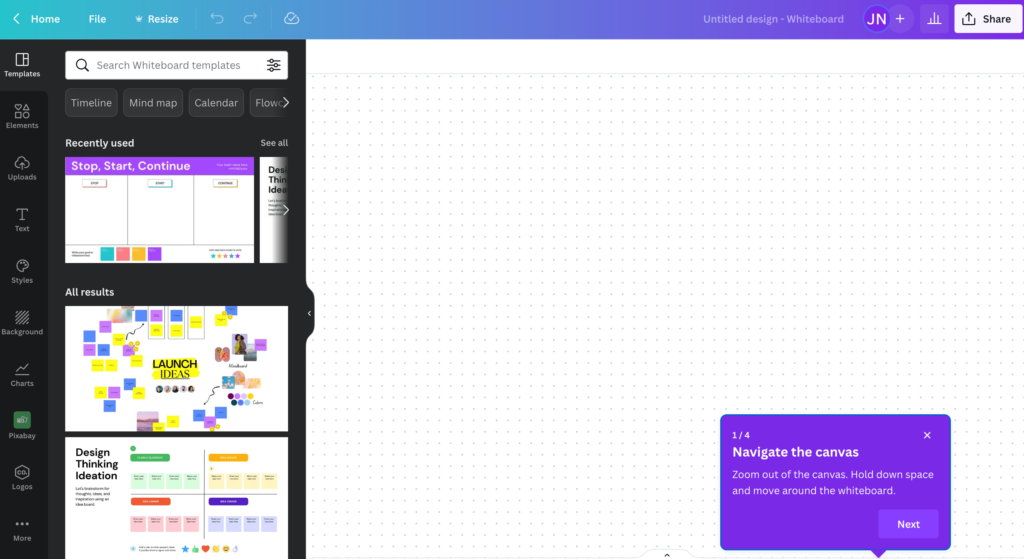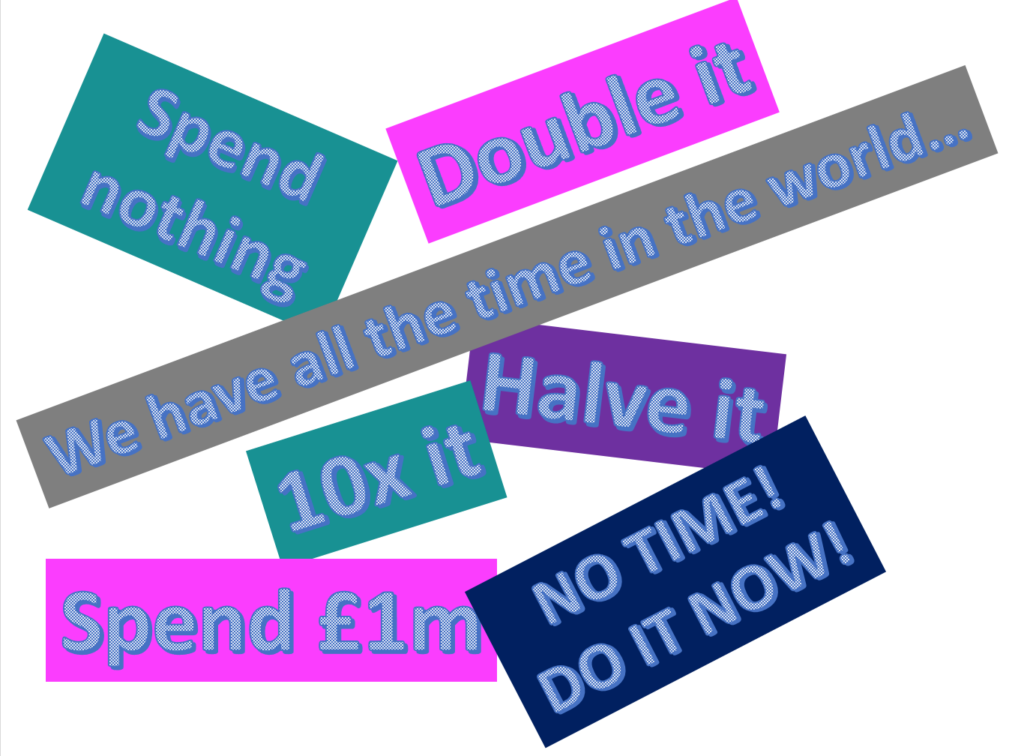Posted in Blog, Facilitation, Innovation, Virtual Facilitation by Jo North
How to facilitate a virtual brainstorming session
In this article I am going to share some of my favorite brainstorming activities that you can use in your online meetings and remote workshops. You can use these to give energy to your sessions, and get people problem solving and generating ideas together.
Giving structure to your brainstorming sessions is always a good idea because simply asking people to brainstorm is largely ineffective. Having focused, well-designed brainstorming activities makes sure that your teams get involved and target their creativity.
Premature evaluation kills creativity
As you’re doing these virtual brainstorming activities in your sessions, remember that not every idea is going to be viable or a good idea, and that’s OK!
We use a different part of our brain to generate ideas than we do to to evaluate and critique those same ideas.
Let the ideas run free and don’t get in the way of them. Get them all out there!
And a rubbish idea can lead to a really good idea further down the line, so getting ideas out means that your workshop participants can then free up their thinking to move on and think about other things.
Once they’ve come up with a lot of ideas, your meeting attendees can evaluate those ideas and decide which ones have potential and which ones don’t.
And don’t forget that even if an idea is not viable, it may be the one thing that sparks another idea in somebody else!
Have a look at my articles here on How to Get Ideas Flowing in Online Meetings and Group Dynamics for Facilitators for more tips, insights and advice.
Virtual brainstorming tools
Great virtual brainstorming tools allow people to collaborate online in realtime easily, replicating many of the paper tools that you might use in an in-person workshop.
Virtual brainstorming whiteboards
Virtual whiteboards, such as Miro or Mural, are great, with Miro being my personal go-to because it’s so intuitive for delegates. The video below helps you to get started with Miro.
Another great online whiteboard option is from Canva. Delegates can workshop, brainstorm, collaborate on an infinite canvas, and view each other’s contributions as they are made. This will not only make it easier for teams to work together, but also make it fun and easy to collaborate with your team and bring your ideas to life while encouraging more workplace collaboration and productivity.

When running a virtual brainstorming workshop in a virtual whiteboard, you can:
- Share the link with participants before the meeting so they can prepare in advance.
- Run the session in real time with multiple participants at once.
- Save and share the resulting work after the session.
- Easily build on top of what was created during the workshop.
If you’re facilitating a virtual brainstorm via Zoom, it’s whiteboard has less functionality than Miro or Mural, but still might be a good and convenient option for you.
Virtual whiteboards also have the facility to download delegates’ work as pdfs and other formats, making it really easy to collate all the great ideas people come up with in your online brainstorming session.
Polling tools for ranking and voting on virtual brainstorming ideas
There are also some great collaboration tools for ranking and voting on the ideas that people generate in your virtual brainstorming sessions. The ones I use the most are Slido occasionally, my most preferred being Mentimeter.
How to do virtual brainstorming
Having structured activity works much better than asking people to shout ideas for someone to write down on a blank page.
Virtual brainstorming activities are designed to get people thinking differently. They are techniques that disrupt habitual ways of thinking to help your delegates come up with fresh ideas. Try some of my top 7 favorite brainstorming activities from the list below.
In your role as facilitator, it’s important to be playful and confident when you brief in your chosen virtual facilitation techniques, encouraging delegates to keep building on their ideas, rather than closing them down too quickly.
More tips for facilitating a virtual brainstorming session
When you’re facilitating a virtual brainstorming session, you need to make sure that your participants can engage and contribute their ideas. Here are some tips for making sure that happens:
- Determine the ground rules ahead of time. This will set expectations and help everyone feel comfortable.
- Ground your participants in the problem before you start generating ideas. If they don’t understand the problem, they won’t be able to generate good solutions.
- Make it easy for participants to share their ideas by providing them with an idea sharing platform, such as an idea board using a virtual whiteboard.
- Encourage participation and discourage criticism. Now is not the time to critique people’s ideas; just get them out there!
When you’re facilitating a team working virtual, there are a few other key things to keep in mind.
First, sure you use a great icebreaker activity or icebreaker question to get everyone into the session.
Then, make sure that everyone is actively participating in the virtual brainstorming session. Without the physical presence of your colleagues, it can be easy to miss a turn or get distracted by other tasks. That’s why it’s important to have a leader who facilitates the meeting and makes sure that everyone’s voice is heard. You can also try using breakout rooms in Microsoft Teams or Zoom to help keep people engaged and on track.
Next, be clear about the goal of your virtual brainstorming session. You should set a time limit for each topic that you’re discussing so that you don’t get carried off into tangents and lose sight of your objectives. This will help you make better use of your team’s time and ensure that all of your ideas are relevant and valuable. If you need extra inspiration, try using online tools like Mindmeister or Trello boards to create something visual for everyone to reference during their virtual brainstorming sessions.
Finally, ask for feedback after each virtual brainstorming meeting so that you can improve your collaboration process. You could send out an anonymous survey asking people what worked well and what didn’t work as well—or just do an informal feedback session.
Do you have any additional tips for facilitating a virtual brainstorming session? Share them in the comments!
Top 7 favorite virtual brainstorming activities
Some of my favorite virtual brainstorming activities are:
- Thirty circles
- Random stimulus
- Exaggeration
- SCAMPER
- Exaptation
- Inspired by greatness
- The Lotus Blossom technique
Here’s a description of each of these virtual brainstorming activities, along with guidance on how to use each of them.
1. Thirty Circles
This brainstorming activity can be used as an icebreaker or as a great idea generation technique.
Thirty Circles provides some constraints, which are great for creativity because they make everyone think differently. The Thirty Circles activity also makes people stretch their thinking a little bit, because getting to 30 ideas is quite a challenge. The first few ideas are usually pretty easy, but thirty is a more of a head stretch.
To brainstorm:
- Ask attendees to take a blank sheet of paper and quickly draw thirty circles. You can also use a Miro board or other virtual whiteboard for this activity.
- Brief the attendees to list as many ideas as possible for the challenge at hand by filling in the circles. Every circle should be turned into an idea.
This activity can be done individually or as a group, depending on the setting you are in and the tools you are using (i.e. virtual whiteboard vs. individual pieces of paper).
Examples of challenges:
- Thirty different ways to be creative or improve your employee communication strategy.
- Thirty different ways to redesign a product or do something different with a product or service.
2. Random Stimulus
This brainstorming activity is called Random Stimulus because you ask participants to take something random, come up with a set of thoughts associated with that random item and then “force fit” all of those words, thoughts and phrases into potential solutions for your challenge.
“Force fitting” means making unusual connections between ideas or items that don’t normally fit together. If there are no immediate connections, then you look for some, which is great fun and creatively stimulating.
To brainstorm:
- First, select an object, a word, a phrase, a song, a piece of music, etc.
- Next, ask attendees to watch something, use an object, look at a word, and then write down all the things that come to mind.
- Finally, the attendees will think about the challenge/opportunity at hand and will “force fit” all of the words and/or thoughts they came up with into a solution for the challenge/opportunity.
Example:
I want to come up with a marketing campaign for business growth My random object is a red pen.
I think up words that describe my red pen.
It’s red, functional, ergonomic, comfortable, etc.
Now I ‘force fit’ each of those words into potential solutions for my marketing campaign.
Red – This is a bold word, so that means that the campaign should stand out.
Ergonomic – How can I get that in front of people in a way that’s comfortable for them?
Comfortable – How can I make my product feel like ‘home’, etc.
3. Exaggeration
This brainstorming activity is super easy and effective, and always creates lots of ideas.

To brainstorm:
- Determine what the challenge or opportunity is that your participants are trying to solve. You’ll find my article on creating challenge statements here useful for this.
- Delegates ask themselves questions that exaggerate the size of the challenge up or down.
Here are some example brainstorm questions that you can ask your participants to work on:
- What if we had no choice but to solve this challenge, and we couldn’t spend anything, we had to do it at zero cost?
- How might we solve this challenge with half the money that we currently spend on it?
- What might we do if could spend a million dollars (or insert a substantial amount that’s appropriately extravagant) solving this challenge?
- If we had had to solve this challenge immediately, what would we do?
- What about if we had all the time in the world to solve this challenge? What approach would we take then?
In doing this, you’re successfully getting your participants to really stretch all the different constraints and opportunities around working through the challenge, and seeing where it takes them.
This can have quite surprising results. Some of the ideas might be doable, whether or not you had a million dollars to spend.
4. SCAMPER
SCAMPER is a classic brainstorming activity that was first introduced by Bob Eberle. It uses targeted questions to generate ideas and solve problems more creatively.
The SCAMPER technique is based very simply on the idea that anything new is actually a modification of existing old things around us.
The name SCAMPER is an acronym for seven thinking activities:
- S—Substitute (e.g., components, materials, people)
- C—Combine (e.g., mix, combine with other assemblies or services, integrate)
- A—Adapt (e.g., alter, change function, use part of another element)
- M—Magnify/Modify (e.g., increase or reduce in scale, change shape, modify attributes)
- P—Put to other uses
- E—Eliminate (e.g., remove elements, simplify, reduce to core functionality)
- R—Rearrange/Reverse (e.g., turn inside out or upside down)
This brainstorming activity works by asking participants to take a challenge and use the acronym scamper to think about different ways of doing things.
Example:
Company A is aiming to find a product to stop cats from scratching sofas and furniture in the home. The challenge is to figure out a product that would stop the cat from doing those things. Here is how you the team might use SCAMPER to brainstorm different ideas, working through each of the SCAMPER ‘letters’ in turn.
Substitute:
How might we substitute different materials that don’t get damaged when scratched?
Combine:
Could we combine the furniture with some covers or other things?
Adapt:
In what ways might we adapt the furniture so that everything’s too high or too awkward for the cats to scratch?
Eliminate:
How about eliminating the furniture and managing without it entirely?
And so on.
As you can see, there are different ways you can look at the problem of the cat scratching the furniture to generate fresh approaches.
Sometimes I will ask teams to work in breakouts, each breakout working on a different set of SCAMPER letters.
5. Exaptation
Exaptation comes from biology, and it’s a fairly recent word. It’s one of those words that was probably created around the 1980s.
Exaptation is the process by which features acquire functions for which they were not originally adapted or selected. Or, put a little differently, sometimes a solution can be created for one purpose, and we discover that it’s also useful for a completely different purpose that we didn’t expect.
For example, the prescription drug fluoxetine was created as an antidepressant, but it has also been found to help with irritable bowel syndrome and stomach complaints.
As a brainstorming activity, teams can use the principle of exaptation is to explore how you to use something for a purpose other than what it was intended for to generate new ideas and disrupt “stuck” thinking. In my podcast here, you’ll hear how Tim and Paul from National Nuclear Laboratory used a can opener in an innovation session to start a brainstorming chain reaction that led to a super-creative solution for a real-life, complex technical engineering challenge.
6. Inspired by greatness
For this brainstorming activity, select six well-known people or organizations that are great at something or have a significant strength. These people or organizations do not have to be perfect and do not have to be related to the topic of your workshop in any way.
Some of the examples I often use are Lady Gaga, Apple, Amazon, Michelle Obama, Walt Disney, NASA amongst others. I give each famous person and organization a number from 1-6.

I allocate the group to breakout teams and either ask each team to select a number at random from one to six or roll a physical or virtual die on screen. This brings an element of fun and randomization, which helps with creative thinking. The number selected or rolled determines the inspiration person or organization for that breakout group. Teams then approach their challenge from how they think that person or organization would approach their challenge, mind mapping the ideas as they go.
Example:
Let’s say your workshop is all about positively transforming the customer service experience.
One breakout team randomly rolled a 3, and a 3 is for Amazon.
The questions the breakout team would then ask themselves are:
- How would Amazon tackle transforming their customer service experience?
- If Amazon came in and had to sort this out, what would Amazon do about it?
- What solutions would Amazon put in place?
The breakout group then works through these questions to get as many ideas as possible.
Once they have generated as many ideas as possible, the breakout group then selects the ones they think might work for the workshop challenge.
7. The Lotus Blossom technique
The Lotus Blossom technique is a super alternative to group mind mapping. I’ve got a full article here on the Lotus Blossom technique and how to use it as a brainstorming activity, also check out my video below.
Next steps
For more free innovation and facilitation resources, check out my Content Studio. Also hop over to my YouTube Channel for more facilitation tips and activities, too.

